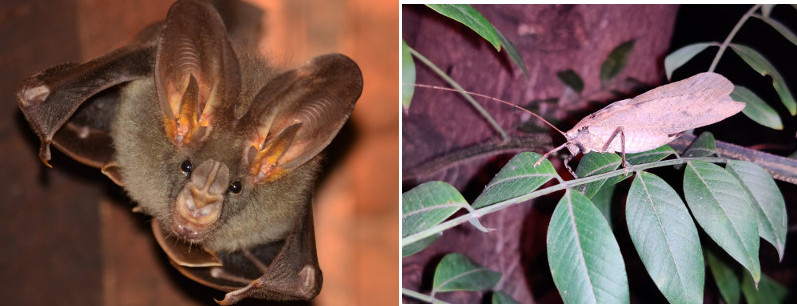Acoustically eavesdropping bat predators take longer to capture prey signalling in aggregation
Mon, 2021-05-31 14:34
Photo credit: Harish Prakash
Male crickets call at night to attract females and mate. These creatures are known to come together with their own kind as a group and signal as well. Since calling in a group is louder than calling alone, it attracts more females and hence more mating opportunities for the advertising males. Signalling males are however at risk of also attracting eavesdropping predators like bats. What happens to this risk when you are calling in a group? Does the risk of attracting predators increase? Being part of a group dilutes your chance of being eaten. For example, if you are one among ten, the chance of being eaten is one-tenth. But are there any other advantages to calling in a group?
Harish Prakash et al. tested whether calling in a group benefits katydids against bat predators. In a choice experiment they found that bats (Megaderma spasma) were more attracted to three speakers playing Mecopoda katydid prey calls than a single speaker. So, does this mean calling together in a group is riskier? Yes. But that is just one part of the story. They also tested how long it takes for bats to capture a calling katydid prey when it is alone compared to when it is in a group of simultaneously calling katydids. Bats took considerably longer to capture a katydid calling in a group of three than when the katydid was calling alone. This delay in capture time gives the katydid an opportunity to stop calling, hide and escape being eaten. So, though katydids calling in a group attract bats, the bat's inefficiency in capturing prey in groups can benefit katydids. Why do bats take more time to capture prey calling in a group? One possible reason could be a confusion effect: it is harder for a predator to target and capture one individual prey when it is among many. Previous studies had looked at this only in visual predators like monkeys, geckos and fish. Our study provides the first evidence for an auditory confusion effect in eavesdropping predators.
Link to the publication:
Prakash, H., Greif, S., Yovel, Y., & Balakrishnan, R. (2021). Acoustically eavesdropping bat predators take longer to capture katydid prey signalling in aggregation. Journal of Experimental Biology Vol. 224 (10), jeb233262
https://journals.biologists.com/jeb/article-abstract/224/10/jeb233262/26...
